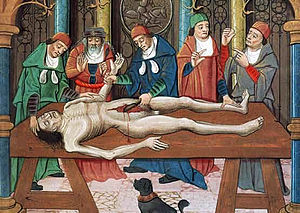Our website is made possible by displaying online advertisements to our visitors.
Please consider supporting us by disabling your ad blocker.
History of anatomy

The history of anatomy spans from the earliest examinations of sacrificial victims to the advanced studies of the human body conducted by modern scientists. Written descriptions of human organs and parts can be traced back thousands of years to ancient Egyptian papyri, where attention to the body was necessitated by their highly elaborate burial practices.
Theoretical considerations of the structure and function of the human body did not develop until far later, in ancient Greece. Ancient Greek philosophers, like Alcmaeon and Empedocles, and ancient Greek doctors, like Hippocrates and his school, paid attention to the causes of life, disease, and different functions of the body. Aristotle advocated dissection of animals as part of his program for understanding the causes of biological forms. During the Hellenistic Age, dissection and vivisection of human beings took place for the first time in the work of Herophilos and Erasistratus. Anatomical knowledge in antiquity would reach its apex in the person of Galen, who made important discoveries through his medical practice and his dissections of monkeys, oxen, and other animals.
Anatomical study continued to build on Galen's work throughout the Middle Ages, where his teachings formed the foundation of a medical education.[1] The Renaissance (or Black Death) brought a reconsideration of classical medical texts, and anatomical dissections became once again fashionable for the first time since Galen. Important anatomical work was carried out by Mondino de Luzzi, Berengario da Carpi, and Jacques Dubois, culminating in Andreas Vesalius's seminal work De Humani Corporis Fabrica (1543). An understanding of the structures and functions of organs in the body has been an integral part of medical practice and a source for scientific investigations ever since.
- ^ Lindemann, Mary (2010). Medicine and Society in Early Modern Europe (2nd ed.). Cambridge, United Kingdom: Cambridge University Press. p. 91.
Previous Page Next Page


